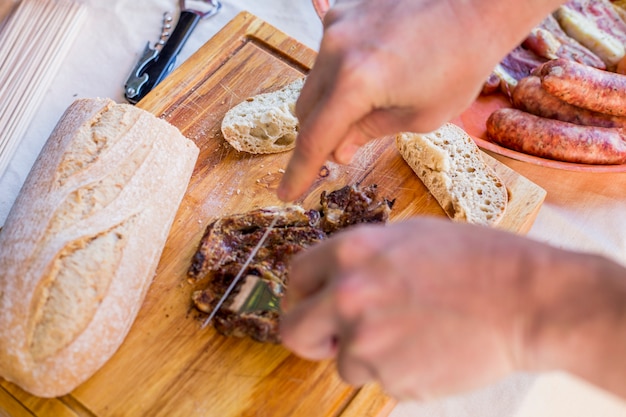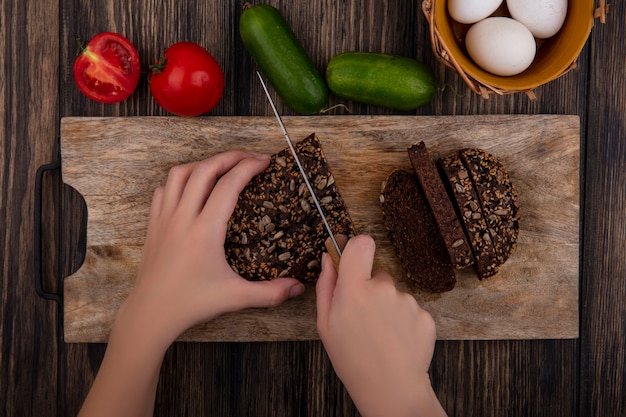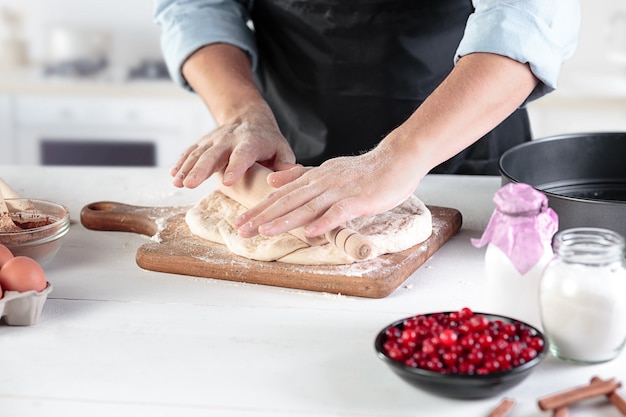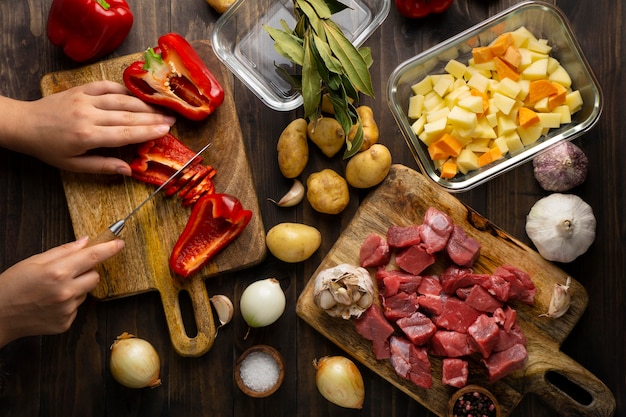Ah, meatloaf. The humble, hearty, and undeniably delicious dish that has been a staple in kitchens for generations. It's a comforting classic, and honestly, a real crowd-pleaser. As a seasoned cook (and lover of all things meaty), I've had my fair share of meatloaf experiences, some good, some... well, let's just say, not so good. But through years of experimentation, I've finally cracked the code to making a truly perfect meatloaf. And now, I'm here to share all my secrets with you.
This guide will be your ultimate companion on your meatloaf journey. We'll dive deep into each step, from choosing the right ingredients to perfecting the baking process. So grab your apron, gather your ingredients, and let's embark on this culinary adventure together!
Part 1: The Foundation – Choosing the Right Meat

Let's start with the heart of the matter: the meat. It's the foundation of your meatloaf, and you can't just throw any old mince in there and expect magic to happen. Now, I have a soft spot for good ol' beef mince, but the world of meatloaf is your oyster (or should I say, your butcher's counter!). Feel free to experiment with pork, lamb, or even a blend of different meats. The key is to find a flavour profile that speaks to your soul.
The Ideal Mince
The secret to a juicy, flavorful meatloaf is in the fat content of the mince. You don't want it to be too lean, as that will result in a dry, crumbly loaf. Aim for a mince that's around 80/20, meaning 80% lean meat and 20% fat. This will give you a delicious balance of flavour and moisture. If you're feeling adventurous, you can try a blend of 80/20 beef mince with a bit of ground pork or lamb for an extra layer of richness.
A Quick Tip: Brown It!
Here's a little trick I've learned over the years: browning your mince before adding it to the loaf. It might seem like an extra step, but trust me, it's worth it. Browning the mince adds an incredible depth of flavour that you just can't get by simply mixing it raw.
To brown the mince, simply heat a large skillet over medium heat. Add the mince and cook, breaking it up with a spoon, until it's browned all over. Drain any excess fat, and then set the mince aside until you're ready to assemble the loaf.
Part 2: The Flavor Makers – Breadcrumbs and the Binding

Now, we're moving on to the ingredients that will add texture, moisture, and a bit of magic to our meatloaf. We're talking about breadcrumbs and the binding agent – two key components that will ensure your loaf is delicious and holds its shape beautifully.
The Breadcrumb Story: Beyond the Basics
Breadcrumbs are the secret weapon to achieving a moist and crumbly meatloaf. You can use plain white breadcrumbs, panko breadcrumbs, or even make your own from stale bread. I've tried them all, and my go-to choice is plain white breadcrumbs. They soak up the moisture from the meat perfectly, creating a beautifully textured loaf.
If you want to add a bit of crunch, panko breadcrumbs are a fantastic option. They're larger and crispier than regular breadcrumbs, giving your meatloaf a delightful textural contrast. And if you have some stale bread lying around, don't throw it away! Simply pulse it in a food processor to make homemade breadcrumbs. It's a great way to reduce food waste and add a personal touch to your meatloaf.
The Binding Agent: Eggs, Milk, or Both?
Now, let's talk binding agents. These are the heroes that hold everything together, preventing your meatloaf from falling apart when you slice it. The classic choices are eggs and milk. You can use either, or even a combination of both.
Personally, I find that a single egg and a splash of milk work perfectly for me. The egg adds richness and helps bind the meat mixture, while the milk adds moisture and prevents the loaf from becoming dry. However, the perfect ratio will depend on your preferences and the specific recipe you're using.
If you're using a recipe that calls for a lot of vegetables, you might want to add an extra egg or a bit more milk to ensure the loaf holds together properly.
Part 3: Seasoning Your Way to Success

Okay, we've got the meat, breadcrumbs, and binding agent – now it's time to add some serious flavour! This is where you can unleash your culinary creativity and personalize your meatloaf with your favourite herbs and spices.
The Classic Blend: A Taste of Tradition
For a classic meatloaf, you can't go wrong with a simple blend of salt, pepper, garlic powder, and onion powder. This timeless combination brings out the natural flavour of the meat and adds a delightful aroma. You can also add a pinch of dried thyme or parsley for extra depth. I also like to add a touch of paprika for a subtle smokiness.
Get Creative with Spices: Explore New Flavors
But hey, don't feel limited to the classics! If you're feeling adventurous, try adding in some other spices to create unique flavour profiles. Smoked paprika adds a deep, smoky flavour, while cayenne pepper provides a gentle heat. A dash of chili powder will give your meatloaf a fiery kick.
For a fresh, herbaceous flavour, try adding chopped fresh herbs like rosemary, sage, or oregano. Just remember to add your seasonings gradually, tasting as you go, to achieve the perfect balance of flavours.
Part 4: The Extras – Boosting Flavour and Texture
We're nearing the finish line, but it's not time to rest on our laurels just yet. Now we'll add some extra ingredients that will take our meatloaf from good to extraordinary. Think of these as the secret ingredients that will give your loaf an extra layer of flavour and texture.
The Power of Chopped Vegetables
Adding chopped vegetables to your meatloaf not only adds moisture and texture but also adds a delightful boost of flavour. My personal favourite is finely chopped onion. It adds a subtle sweetness and a beautiful aroma to the loaf. You can also try finely chopped carrots, celery, or even bell peppers for extra colour and flavour.
The key is to pre-cook your vegetables before adding them to the mixture. This will prevent them from releasing too much moisture into the meatloaf, which can make it soggy. Simply sauté them in a bit of olive oil or butter until softened, and then add them to the meatloaf mixture.
The Umami Bomb: Mushrooms
Now, here's a secret I learned from my grandmother: add chopped, sautéed mushrooms to your meatloaf mixture. This little trick will add a depth of umami flavour that you won't believe. It's a delicious way to enhance the meaty taste of the loaf.
Just like with the other vegetables, make sure to sauté the mushrooms until they're softened before adding them to the meatloaf mixture.
Part 5: Bringing It All Together: Shaping the Loaf
Alright, we've got our delicious meat mixture ready – now it's time to shape it into a beautiful, majestic meatloaf. This step requires a little finesse, but trust me, it's not as difficult as it seems.
The Loaf Mold: A Variety of Choices
Traditionally, meatloaf is shaped in a loaf pan. But you're not limited to that! You can also use a baking dish, a casserole dish, or even a dutch oven. The key is to choose a container that's deep enough to accommodate the loaf and allow it to bake evenly.
Forming the Loaf: Gentle Shaping
Now, it's time to get our hands dirty. Gently press the meat mixture into your chosen container, shaping it into a loaf. Make sure it's firm and evenly spread. If you're feeling fancy, you can try creating a smooth top or even adding some decorative swirls. But honestly, even a simple, rustic shape will taste just as good.
Part 6: The Finishing Touches – Glaze and Garnish
We're in the final stages, and it's time to add the finishing touches that will take our meatloaf from good to incredible. Think of these as the cherry on top, the finishing flourishes that will make your meatloaf look as delicious as it tastes.
A Glaze to Remember: A Sweet and Savoury Symphony
A glaze is a fantastic way to add colour, flavour, and a beautiful, glossy finish to your meatloaf. My go-to glaze is a simple mixture of ketchup, brown sugar, and a bit of Worcestershire sauce. This creates a sweet and tangy glaze that perfectly complements the savoury meatloaf.
If you're feeling adventurous, try experimenting with other glaze options like barbecue sauce, honey mustard, or even a simple glaze made with Dijon mustard and brown sugar.
Garnish with Style: A Touch of Freshness
Now, let's add some final touches that will make your meatloaf look as good as it tastes. A simple garnish of chopped parsley or a sprig of thyme adds a touch of freshness and elegance to the presentation. You could even try adding a few slices of bacon or some toasted breadcrumb topping for a more rustic look.
Part 7: Baking Your Way to Perfection: The Heat is On
Finally, we're ready to bake our masterpiece! This is a crucial step that requires a bit of patience and attention. We want to bake our meatloaf to a perfect level of doneness, ensuring it's cooked through without becoming dry or overcooked.
Preheating the Oven: Setting the Stage
First things first, preheat your oven to 350°F (175°C). This will ensure the meatloaf cooks evenly and quickly. Now, place your meatloaf in the oven and bake for approximately 1 hour and 15 minutes.
The doneness test: Don't Overcook
The best way to check if your meatloaf is done is to use a meat thermometer. Insert it into the center of the loaf, and if it reads 160°F (71°C), it's ready. You can also check if the loaf is firm to the touch, and if the juices run clear when you poke it with a fork.
Resting Time: Allowing the Juices to Redistribute
Once the meatloaf is cooked, let it rest for 10-15 minutes before slicing and serving. This allows the juices to redistribute throughout the loaf, making it even more tender and juicy.
Part 8: Serving and Enjoying Your Culinary Masterpiece
Congratulations! You've successfully baked a delicious, homemade meatloaf. Now, it's time to enjoy your culinary triumph.
Sides to Pair: Classic and Creative
A classic meatloaf pairs perfectly with a variety of sides. Here are a few of my favourites:
- mashed potatoes: A timeless combination that's both comforting and delicious.
- green beans: A fresh and vibrant contrast to the richness of the meatloaf.
- corn on the cob: A classic summer side that's perfect for a family gathering.
- Roasted vegetables: A healthy and flavorful option that adds a touch of colour to the plate.
- A simple salad: A light and refreshing side that balances the richness of the meatloaf.
The Perfect Slice: A Slice of Heaven
Now, grab a sharp knife and slice your meatloaf into generous portions. Be sure to cut it evenly and neatly so each slice looks as good as it tastes.
Serving Time: A Celebration of Flavour
Serve your meatloaf hot with your chosen sides. It's a real crowd-pleaser, guaranteed to satisfy even the most discerning palate. You can also serve it cold as part of a picnic or buffet spread. It's a versatile dish that can be enjoyed in many ways.
Part 9: meatloaf variations - Let's Get Creative
Okay, now that you've mastered the basics, it's time to get creative with your meatloaf. There are endless variations you can try, each offering a unique flavour and texture. Let's explore some exciting possibilities.
Adding Some cheesy goodness: A Melty Delight
Let's start with the classic. Adding cheese to your meatloaf is a surefire way to elevate it to a new level of deliciousness. You can use any type of cheese you like, but I prefer cheddar or a sharp Swiss for their distinct flavours and melty textures. Simply grate the cheese and sprinkle it over the loaf before baking. The cheese will melt during baking, creating a gooey, cheesy layer that's irresistible.
Going for a Spicy Kick: A Touch of Heat
If you prefer a bit of heat, why not add some spice to your meatloaf? You can use chili powder, cayenne pepper, or even some jalapeno peppers for a fiery flavour. Just remember to add the spices gradually, tasting as you go, to avoid overwhelming the flavour of the meat.
Introducing the Mediterranean Twist: A Flavourful Journey
For a taste of the Mediterranean, try adding some olives, sun-dried tomatoes, and feta cheese to your meatloaf. This combination creates a flavour explosion, with salty olives, sweet sun-dried tomatoes, and creamy feta cheese. It's a delicious twist on the classic meatloaf recipe, bringing a touch of the Mediterranean sunshine to your table.
A Touch of Sweetness: A Balanced Harmony
For those who enjoy a touch of sweetness, why not add some dried fruit to your meatloaf? I love adding dried cranberries or apricots for a burst of sweetness and a chewy texture. Just make sure to chop the fruit finely before mixing it into the meatloaf.
A Vegetarian Option: A Meatless Marvel
You can even make a delicious vegetarian meatloaf! Simply substitute the meat with a mixture of lentils, mushrooms, and oats. You can also add chopped vegetables, herbs, and spices for a flavourful and satisfying vegetarian meal. It's a great option for those who want to enjoy the comfort of meatloaf without the meat.
Part 10: FAQs - Your Meatloaf Questions Answered
Now, let's tackle some of the common questions you might have about making meatloaf. I've gathered some of the most frequently asked questions and provided detailed answers to help you on your meatloaf journey.
1. What if my meatloaf falls apart when I slice it?
If your meatloaf falls apart, it's likely because the binding agent wasn't strong enough. To prevent this, try adding an extra egg or a bit more milk to your mixture. You could also try using breadcrumbs that are slightly coarser, as they will absorb more moisture and help hold the loaf together. Remember, a little extra binding goes a long way in achieving a cohesive meatloaf.
2. How do I know when my meatloaf is done?
The best way to check if your meatloaf is done is to use a meat thermometer. Insert it into the center of the loaf, and if it reads 160°F (71°C), it's ready. You can also check if the loaf is firm to the touch, and if the juices run clear when you poke it with a fork. However, the thermometer is the most reliable method for ensuring that your meatloaf is cooked through.
3. Can I freeze meatloaf?
Yes, you can definitely freeze meatloaf! It's a great way to have a quick and easy meal on hand. Simply wrap the cooled meatloaf tightly in plastic wrap and then in foil. You can freeze it for up to 3 months. To reheat, thaw the meatloaf in the refrigerator overnight and then reheat it in a preheated oven at 350°F (175°C) until heated through. Frozen meatloaf is a lifesaver for busy weeknights.
4. What if my meatloaf is too dry?
If your meatloaf is too dry, it's likely because you used too lean a mince or added too many breadcrumbs. Next time, try using a fattier mince or reducing the amount of breadcrumbs. You can also add a bit more liquid to the mixture, such as milk or stock. Remember, moisture is key to a juicy meatloaf.
5. What are some other ways to use leftover meatloaf?
Leftover meatloaf is a culinary chameleon! You can use it in sandwiches, salads, or even as a topping for baked potatoes. You can also chop it up and use it in a shepherd's pie, or add it to a pasta sauce for a meaty twist. The possibilities are endless!
Part 11: Conclusion - Your Meatloaf Journey Begins
There you have it, folks! Your complete guide to making perfect meatloaf. Now, I know it might seem like a lot to take in, but trust me, once you've mastered the basics, it's a simple dish to make. And let's face it, there's nothing quite like the satisfaction of creating a delicious meal from scratch.
So go forth, my fellow food enthusiasts, and unleash your culinary creativity! Experiment with different flavours, try out different variations, and most importantly, have fun! And if you end up with a meatloaf that's even better than mine, I want to hear all about it. Happy cooking!
Everyone is watching

Perfect Rice Every Time: The Ultimate Guide to Cooking Rice
Cooking TipsAs a self-proclaimed foodie, I've always been a bit obsessed with rice. It's the foundation of countless cuisi...

The Ultimate Guide to Cooking Asparagus: Tips, Techniques, and Recipes
Cooking TipsAsparagus. The mere mention of this spring delicacy conjures up images of vibrant green spears, crisp and burs...

Ultimate Guide to Cooking the Perfect Thanksgiving Turkey
Cooking TipsThanksgiving. Just the word conjures up images of overflowing tables laden with delicious food, the scent of r...

Can You Cook Spaghetti with Gasoline? (The Shocking Truth)
Cooking TipsWe've all seen those crazy internet trends. You know, the ones that make you wonder, "Did someone actually try...

Chorizo and Eggs Recipe: The Ultimate Guide
Cooking TipsRight, let’s talk about chorizo and eggs. You know, that classic Spanish dish that's always a winner. It's th...
